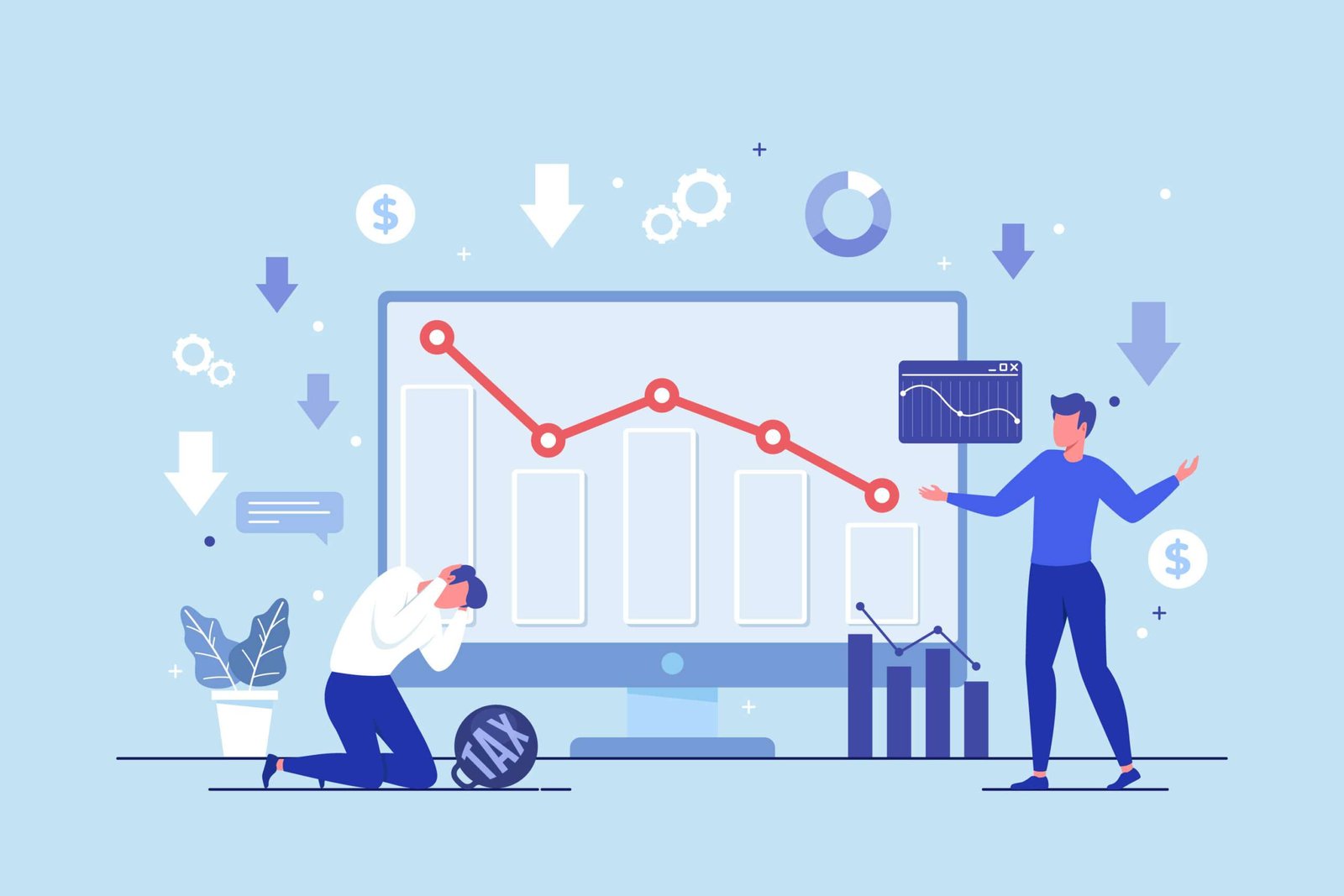Introduction
In the modern digital landscape, a strong online presence is essential for businesses and individuals. Web design and development play an important role in creating and maintaining an attractive and user-friendly website. In this article, we will learn about the importance of web design and development, key elements, best practices and what are the latest trends going on. Whether you’re a business owner looking to establish your brand or an aspiring web developer looking for insights, this article provides valuable information on creating an effective digital identity.
What is Web Design?
Web design is the process of creating and planning the visual elements and layout of a website. It involves using various design principles and techniques to create the overall look and feel of a website, making it visually appealing, user-friendly and relevant to brand identity.
Web design involves many aspects including color scheme selection, typography, graphics, images and overall organization of content. Designers work to create a cohesive and engaging user experience that keeps visitors on a website and encourages them to explore further.
The main elements of web design include the following important elements:
Layout: The arrangement of elements on a web page, including headers, navigation menus, content sections, and footers. Effective layout ensures easy navigation and readability.
Color Scheme: Selection of colors that are consistent with the brand and evoke desired emotions in users. A well-chosen color scheme enhances the visual appeal and user experience of a website.
Typography: Selection of fonts and their sizes for different sections of the website. Typography should be legible and consistent with the tone of the brand.
Graphics and Images: Use relevant and high-quality graphics and images to complement the content and enhance the beauty of the website.
Responsive Design: Designing a website to look responsive and attractive on a variety of devices, including desktops, tablets, and smartphones.
User Experience (UX): Focusing on providing a seamless and enjoyable experience for visitors by ensuring easy navigation, clear call-to-action buttons and fast loading times.
Web designers use many design software to create visual mockups of websites. They collaborate with web developers to ensure that designs can be effectively implemented and work as intended. Overall, web design plays a vital role in attracting and retaining visitors, establishing brand recognition and contributing to the overall success of a website. A well-designed website leaves a lasting impression on users and can increase conversions and engagement.
What is Web Development?
Web development is the design, creation and maintenance of websites and web applications. This includes the technical implementation of website design and functionality, bringing the visual elements to life and ensuring that the website functions smoothly and efficiently. Web developers are responsible for writing the code that runs a website and enables its interaction. They use various programming languages, frameworks and tools to create the front-end and back-end components of a website. Let’s take a look at the key aspects of web development:
Front-End Development:
Front-end developers work on the client-side of a website, responsible for what users see and interact with directly. They use languages such as HTML (Hypertext Markup Language), CSS (Cascading Style Sheets) and JavaScript to create the layout, style and interaction of web pages.
– HTML: Creates the structure and content of web pages using elements such as headings, paragraphs, images and links.
– CSS: Provides the opportunity to control the presentation and appearance of web pages, element colors, fonts, layout and responsive design.
– JavaScript: Adds interactivity and dynamic features to websites, such as pop-up windows, form validation and animation.
Back-End Development:
Back-end developers handle the server-side processing of a website, which includes managing data, databases, and website functionality that users do not directly interact with. They use programming languages like Python, PHP, Ruby or Node.js to create server-side logic.
– Server-side language: involves processing requests from the front-end, interacting with databases, and performing operations on the server.
– Database: Involves the process of storing and managing data, allowing web applications to retrieve, update, and manipulate information as needed.
– Frameworks and CMS: Web developers often use frameworks like Django, Ruby on Rails, Laravel or content management systems (CMS) like WordPress, Joomla or Drupal to streamline web development and increase website functionality.
Database Management:
Web developers work with databases to efficiently store and manage data. They design and manage database structures, ensuring data integrity and security.
Security:
Web developers implement security measures to protect websites from potential threats and attacks, such as preventing SQL injection, cross-site scripting (XSS), and unauthorized access.
Testing and Debugging:
Web developers perform rigorous testing i.e. debugging to identify and fix any issues or bugs in the website’s code, ensuring optimal performance and functionality.
Version control:
Web developers use version control systems like Git to track code changes and collaborate effectively with other team members.
Application:
Once a website is created, web developers deploy it to a web server, making it accessible to users around the world.
Web development is a dynamic and ever-evolving field, driven by technological advancements and changing user demands. A well-executed web development process results in a functional, responsive and user-friendly website, contributing to a positive user experience and online presence success.
The Relationship between Web Design and Web Development
The relationship between web design and web development is a collaborative and interdependent one, as both disciplines work together to create a successful website. Although they are separate roles, they complement each other to achieve a cohesive and functional digital presence. Let’s take a closer look at the relationship between web design and web development.
Concept and Planning:
Web design and web development often begin with the conceptual phase, where the project’s goals, target audience, and overall vision are defined. Designers and developers work together to understand project requirements and create blueprints for website structure, design, and functionality.
Design to Development Handoff:
Once the web design mockup is ready, it is handed over to the web development team. Designers provide detailed information, including layout, color scheme, typography, and interactive elements, to ensure developers can implement the design accurately.
Front-End Development:
Front-end developers take design files and translate them into code using HTML, CSS, and JavaScript. They are responsible for creating the user interface (UI) and ensuring that the visual elements of the website look good across different devices and browsers.
Back-End Development:
Back-end developers work on the server-side of a website, creating the logic and functionality that powers the website. They handle tasks such as database management, server configuration, user authentication, and data processing.
Responses and Interactions:
Designers and developers collaborate to ensure that a website is responsive and user-friendly on a variety of devices, including desktops, tablets, and smartphones. This includes optimizing images, implementing media queries, and using responsive design techniques.
Content Integration:
Web developers incorporate content provided by content creators or clients into the structure of a website. They ensure that content is properly displayed and aligned with the design layout.
Testing and troubleshooting:
Throughout the development process, designers and developers conduct rigorous testing to identify and fix any issues or bugs. They examine cross-browser compatibility, responsive behavior and overall functionality.
Continuous Communication:
Effective communication is critical in the design and development process. Designers and developers regularly collaborate to discuss progress, address challenges, and ensure the project stays on track.
Repeat process:
The relationship between web design and web development is an iterative one, meaning that a website may undergo many iterations and improvements as it takes shape. Both teams work together to refine and enhance the website until it meets the project’s goals and exceeds user expectations.
Website Maintenance and Updates:
After the website is launched, designers and developers continue to work together for ongoing maintenance and updates. This ensures that the website remains up-to-date, secure and aligned with the evolving needs of the business or organization.
Web design and web development are interlinked disciplines that closely collaborate to create functional, visually appealing and user-friendly websites. Successful implementation of web projects requires a harmonious partnership between designers and developers, ultimately used to achieve positive user experience and website goals.
Elements of web design and development
Key elements of web design and development refer to the essentials and aspects that play a vital role in creating a successful and effective website. These elements include aspects of both visual design and technical development, ensuring that a website is visually appealing, user-friendly and functional. Let’s have a detailed look at the main components below:
User Interface (UI) Design:
UI design focuses on creating an attractive and intuitive layout that engages users and provides easy navigation. This includes designing buttons, menus, sliders and other interactive elements to enhance the user experience.
Visual Design:
Visual design includes the selection of color schemes, typography, and images that align with brand identity and evoke desired emotions in users. Consistent branding elements help establish a strong visual presence.
Responsive Design:
With the increasing use of various devices such as smartphones and tablets, responsive design is essential. This ensures that the website works and displays properly on various screen sizes and resolutions.
Content Management System (CMS):
A CMS allows website owners to easily manage and update content without requiring technical knowledge. It streamlines content publishing and enables efficient content management.
Accessibility:
Web accessibility ensures that a website is usable by all individuals, including those with disabilities. This includes providing images, keyboard navigation, and alternative text for diverse audiences.
Front-End Development:
Front-end development involves converting design files into code using HTML, CSS, and JavaScript. It focuses on creating user interfaces and delivering a seamless user experience.
Back-End Development:
Back-end development handles the server-side of the website, managing the database, server configuration and application logic. This ensures the functionality of the website and helps enable data processing and storage.
Search Engine Optimization (SEO):
SEO techniques are important for improving a website’s visibility in search engine results. Web design and development must incorporate SEO best practices to increase organic search rankings.
Website Speed and Performance:
Optimizing website speed and performance is important for user experience and search engine rankings. Reducing page load times and optimizing images are some of the techniques used to improve performance.
Call-to-Action (CTA) Elements:
Well-designed and visually appealing CTAs motivate users to take the desired action, such as signing up for a newsletter, making a purchase, or contacting a company.
Cross-Browser Compatibility:
It is essential to ensure that the website works consistently and effectively across different web browsers to provide a seamless experience to users. It requires cross-browser checking.
Social Media Integration:
Integrating social media platforms allows users to share content and helps increase website reach and engagement.
Analytics and Tracking:
Implementing analytics tools enables website owners to monitor and analyze user behavior, traffic sources and other valuable insights to make data-driven decisions.
Testing and Quality Assurance:
Regular testing and quality assurance helps identify and fix any issues or bugs before the website goes live, ensuring a smooth user experience.
Key elements of web design and development are essential to creating functional, visually appealing and user-friendly websites. By incorporating these elements, web designers and developers create websites that provide a seamless user experience, increase traffic, and achieve website goals.
Importance of Web Design and Development
The importance of web design and development in today’s digital age cannot be overstated. A well-designed and developed website is important for businesses, organizations and individuals looking to establish a strong online presence and succeed in the competitive online landscape. Following are the main reasons why web design and development is of utmost importance:
Website First Impression Matters:
A website is the first point of contact between a brand and its potential customers. A visually appealing and well-designed website grabs the attention of visitors and encourages them to explore further.
User Experience (UX):
User experience is central to web design and development. A well-designed website ensures intuitive navigation, easy access to information and a smooth browsing experience. A positive UX leads to higher engagement and encourages visitors to stay longer on the website.
Brand recognition and credibility:
A professionally designed website conveys strong brand recognition and credibility. Consistent branding elements such as logos, colors and typography instill confidence in users and help build brand identity.
Mobile Responsiveness:
With the increasing use of mobile devices, having a responsive website is imperative. Mobile Responsiveness ensures that a website adapts to different screen sizes, providing a seamless experience on smartphones and tablets.
Lead Generation and Conversion:
A well-designed website with clear call-to-action (CTA) elements increases lead generation and conversion rates. Engaging CTAs encourage visitors to take a desired action, such as signing up for newsletters or making a purchase.
Competitive advantage:
In a competitive market, a visually appealing and user-friendly website gives businesses a competitive advantage. It helps businesses stand out from their competitors and leaves a lasting impression on users.
Ease of Content Management:
Web development using a Content Management System (CMS) makes content management easier for website owners. CMS platforms allow for easy updates and changes to content without requiring technical expertise.
Analysis and Data Insights:
Web design and development includes analytics tools to track user behavior and gather valuable insights. These insights help in understanding user preferences, improving website performance and making data-driven decisions.
Scalability and Adaptability:
A well-developed website allows for scalability and adaptability as a business grows and needs change. It can accommodate new features, materials and functionality without major overhaul.
Customer Engagement and Interaction:
Web design elements, such as interactive forms, chatbots, and social media integration, facilitate customer engagement and interaction. It fosters a sense of community and helps build lasting relationships with customers.
Cost-effectiveness:
Upfront investment in web design and development can yield long-term cost-effectiveness. A well-designed and functional website requires less maintenance and redesign efforts, ultimately saving time and money.
Web design and development is critical to creating a successful online presence and achieving business goals. A user-friendly, visually appealing and functional website enhances user experience, builds brand credibility and increases traffic and conversions. Investing in high-quality web design and development is an important step towards establishing a strong digital identity and staying ahead in the competitive online landscape.
Choosing the Right Web Design and Development Tools
Choosing the right web design and development tools is critical to creating a successful website that meets the project’s requirements and goals. With numerous tools and technologies available, choosing the most appropriate one can significantly impact the efficiency and effectiveness of the web design and development process. Key factors to consider while choosing these tools are as follows:
Project Requirements:
It is important to understand the specific needs and objectives of the project. Consider factors such as the type of website (eg, e-commerce, blog, portfolio), target audience, desired features, and scalability requirements. It is important to choose tools that match the scope and complexity of the project.
Design Tools:
For web design, consider using graphic design software such as Adobe Photoshop, Adobe Illustrator, Sketch or Figma. These tools allow designers to create high-fidelity mockups and wireframes, enabling effective communication with the development team.
Front-End Development Tools:
Front-end developers work with HTML, CSS, and JavaScript. Consider using a code editor and integrated development environment (IDE) such as Visual Studio Code, Sublime Text, or WebStorm to streamline the coding and debugging process.
Front-End Framework:
Front-end frameworks like Bootstrap, Foundation or Materialize provide pre-designed components and responsive layouts, speeding up development and ensuring consistency across websites.
Back-End Development Tools:
Choose the right back-end development tools based on the programming language chosen for the project. For example, Node.js is commonly used for JavaScript-based projects, while PHP, Python or Ruby are popular choices for other applications.
Database Management:
Choose a database management system (DBMS) that meets the needs of the project. Common options include MySQL, PostgreSQL, MongoDB or SQLite. Consider factors such as scalability, performance, and data structure requirements.
Choosing the right web design and development tools is critical to streamlining the development process, achieving project goals, and delivering a successful website. Carefully assessing project requirements, considering design and development tools, and applying testing and optimization tools contribute to creating a website that is user-friendly, visually appealing, and functional.
The Role of SEO in Web Design and Development
The role of SEO (Search Engine Optimization) in web design and development is crucial to ensure a website’s visibility, ranking and overall success in search engine results. SEO is a set of practices and strategies aimed at optimizing a website to improve its organic (non-paid) search engine rankings. It includes both on-page and off-page optimization techniques. Let’s explore the key aspects of SEO in web design and development:
Keyword Research and Integration:
Keyword research is the foundation of SEO. Identifying website content and target audience-relevant and high-traffic keywords helps optimize website content. Web developers and designers work together to strategically integrate keywords into meta tags, titles, and content.
URL Structure and Site Architecture:
A well structured URL structure and site architecture increases the crawlability of a website by search engines. Web designers and developers collaborate to create user-friendly and SEO-friendly URLs by using descriptive keywords and avoiding unnecessary parameters.
Mobile Responsiveness:
Mobile-friendliness is an important factor in SEO. Web design and development should prioritize responsive design, ensuring that a website adapts and works seamlessly on a variety of devices, including smartphones and tablets.
Page Speed and Performance:
Website speed significantly affects user experience and SEO ranking. Web developers optimize code, compress images, and leverage caching techniques to improve page loading times. Fast-loading websites are preferred by search engines and users alike.
Meta Tags and Description:
Web developers and designers collaborate to create unique and attractive meta tags and meta descriptions for each page. These elements provide search engines and users with brief information about the content of a web page.
Meta tags and content structure:
Proper use of heading tags (H1, H2, H3, etc.) organizes content and helps search engines understand page structure. Designers create visually appealing titles, while developers ensure their proper hierarchy and proper meaning.
Image Optimization:
Optimizing images for web design and SEO involves compressing images without compromising quality, adding descriptive alt text, and using appropriate file names. Image optimization improves page loading speed and increases accessibility.
Schema Markup and Rich Snippets:
Web developers can add structured data using schema markup to provide search engines with additional context about content. This can result in rich snippets in search results, improving website visibility and click-through rates.
Authentication and Duplicate Content:
Duplicate content can negatively impact SEO rankings. Web developers use canonical tags to indicate the preferred version of a page, helping search engines identify and index original content.
Sitemap and Robots.txt:
Web developers create XML sitemaps and submit them to search engines, ensuring that all pages are properly indexed. The robots.txt file is used to control access to specific pages on a website by search engine crawlers.
User Experience (UX) and Bounce Rate:
An intuitive and user-friendly website design reduces bounce rates, which can positively impact SEO rankings. Providing engaging and valuable content encourages users to stay on a website longer, sending a positive signal to search engines.
Local SEO:
For businesses targeting a local audience, web design and development should include local SEO elements such as location-based keywords and Google My Business optimization.
SEO plays an important role in web design and development by ensuring that websites are well optimized for search engines and user experience. Collaboration between web designers and developers is essential to implement SEO best practices, resulting in a website that ranks high, attracts organic traffic, and provides a seamless and enjoyable experience to users.
Conclusion
Web design and development are integral to creating a successful and effective online presence. Creating visually appealing, user-friendly, inclusive web design and high-performing websites that engage audiences and achieve business goals requires the collaborative efforts of designers and developers. Through a thoughtful integration of design elements, user experience enhancements, and SEO optimization, websites can stand out in the competitive digital landscape, leave a lasting impression on visitors, and build customer loyalty.
As technology and user preferences continue to evolve, web design and development will remain a dynamic field, requiring constant adaptation and innovation. By emphasizing the importance of responsive design, accessibility, inclusive web design, and mobile optimization, while following SEO best practices, businesses and individuals can establish a strong online identity and stay ahead of the curve. Coordination between web design and development teams is paramount to creating websites that not only reflect brand identity but also provide seamless navigation and exceptional user experience, ultimately contributing to the overall success and growth of businesses in the digital world.



